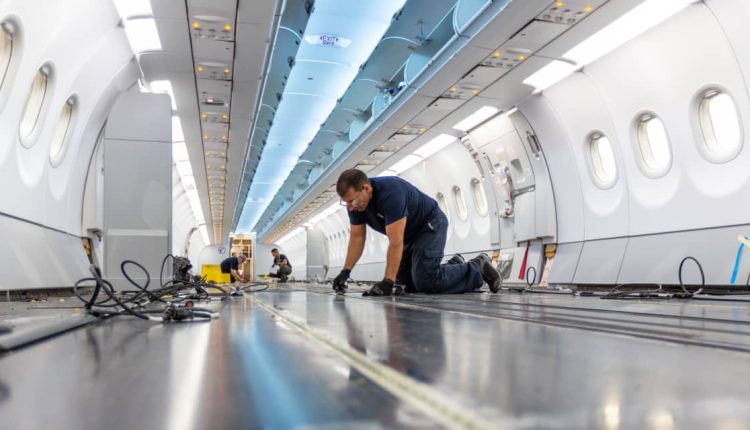Air travel is still recovering, but there’s no need to buy airline stocks to play it. Investors should buy
AAR
instead.
AAR (ticker: AIR) isn’t a household name, but every airline knows it because it sells used, repaired, and overhauled engine and airframe parts they need to keep their planes flying. The $2 billion company also provides repair and maintenance services at seven facilities spread across the North America. What’s more, AAR is an aerospace parts distributor. More planes flying equals more business for the company.
And more planes are in the air. April 2023 was the first month that worldwide domestic air traffic—flights that originate and land in the same country—exceeded prepandemic levels. The domestic airline industry finally put Covid in the rearview mirror. International air traffic is also growing but hasn’t eclipsed prepandemic levels yet. In July, the latest global data available, international travel was about 11% below July 2019 levels. There’s still room for recovery.
But the air-travel revival isn’t the only reason to like AAR stock. Its used-parts business is set to improve as well. Original equipment manufacturers such as
General Electric
(GE) and
RTX
(RTX) supply most of the new spare parts for engines, but airlines also take used parts from authorized suppliers to save money. AAR is a big player in those used parts, which the industry calls “used serviceable material,” or USM.
AAR’s USM business should accelerate as air travel recovers and as deliveries of the newest 737 MAX and A320neo jets from
Boeing
(BA) and
Airbus
(AIR.France), respectively, accelerate, replacing older planes. Many of those older jets fly with CFM56 engines built by GE and
Safran
(SAF.France). The CFM56 is one of the best-selling engines of all time, with more than 33,000 delivered. It’s a big opportunity for AAR, which should have a large supply of new parts from decommissioned airplanes.
| Headquarters | Wood Dale, Ill. |
|---|---|
| Recent Price | $58.35 |
| 52-Wk Change | 37.5% |
| Market Value (bil) | $2.0 |
| 2024E Sales (bil) | $2.2 |
| 2024E Net Income (mil) | $117.5 |
| 2024E EPS | $3.55 |
| 2024E P/E | 16.4 |
Note: Fiscal year ends in May. E=estimate
Source: Bloomberg
“Part of the reason it’s different is it plays in used aircraft parts, where many others don’t,” explains Melius Research analyst Robert Spingarn. “There’s a point [where] airplanes [stop flying] and they get harvested for parts.”
Growth is showing up in results and estimates. In 2019, AAR generated earnings per share of about $2.23 on sales of $2.1 billion, before taking a hit because of Covid-19. But profits have rebounded and are now expected to hit $3.20 on sales of $2.1 billion in 2023. Sales and earnings are projected to grow at about 10% and 16% a year on average between 2023 and 2025.
Growth hasn’t shown up in the valuation multiple yet, though. AAR stock trades for about 16.7 times 12-month forward earnings, below the
S&P 500’s
19.2 times, despite projected earnings growing seven percentage points faster than the benchmark index. Growth like that should be worth 20 times earnings, according to Spingarn, who has a $73 price target on AAR, up more than 25% from a Friday’s close of $57.81.
He isn’t alone in his positive views. All four analysts covering the company rate shares Buy. The average analyst price target is a little lower at $68 a share, up about 18% from recent levels.
Four analysts, however, isn’t a lot—even for a small-cap company. AAR is trying to change that, making it easier for investors to understand what it does. At its analyst event in July, the company announced three new reporting segments—integrated solutions, parts supply, and repair and engineering. Before the change there was less detail about key businesses.
See All the Stocks We’re Bullish—and Bearish—On
There is also a renewed focus on mergers and acquisitions. The company just paid about $120 million cash, plus an additional $20 million depending on how the acquired business performs, for aircraft maintenance service provider Trax. It’s the first significant acquisition since 2017, says the company. Trax sells software that helps companies manage their aircraft maintenance and will help AAR sell more used parts.
“We are now more focused than ever,” AAR CEO John Holmes said at the analyst event. “Anything we do, any investment that we make for organic growth or inorganic expansion, is going to be around these three areas of focus.”
AAR’s balance sheet is well-positioned to add businesses. The company ended May with less than $200 million in net debt on its books. Earnings before interest, taxes, depreciation, and amortization, or Ebitda, are expected to be about $214 million in 2023, for a debt-to-Ebitda ratio of less than one time. The average S&P 500 company operates closer to two times. AAR is also a consistent generator of free cash flow—some $32 million in calendar year 2023.
The outlook and strategy look promising for AAR, making shares a sound bet. Its earnings can grow, and its valuation can expand. That makes the stock a good way to play the continuing recovery in global air travel—this year and beyond.
Write to Al Root at [email protected]
Read the full article here

